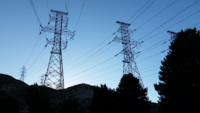
Photo from wikipedia
Abstract Increasing the share of renewable energy sources in power systems is key to a successful energy transition. Optimal renewable site selection requires a holistic approach, involving land, resources, environmental… Click to show full abstract
Abstract Increasing the share of renewable energy sources in power systems is key to a successful energy transition. Optimal renewable site selection requires a holistic approach, involving land, resources, environmental and economical data and constraints. In this paper we consider the problem of solar PV penetration into the power network as a spatiotemporal analysis combined with decision support targeted for policy makers and investors. Our goal is to seek new models that maximize energy penetration and stability into the network, while minimizing the operational costs. We show how the selection of solar PV sites can be accomplished to satisfy such objectives by investigating the optimal clustering of multiple solar PV parks around a shared electrical substation. This is a combinatorial problem in terms of all the potential clusters given the set of PV site candidates. Our main contribution lies in identifying and proposing a modeling analogy of our problem with the so-called SONET problem, tackled in fiber network designs. We show how this new spatiotemporal PV park placement model minimizes operational costs, while increasing energy stability of the solutions produced. We also introduce a GIS preprocessing step to reduce the computational cost of the proposed approach. We compare our proposed SONET-based model to an existing GIS-optimization model on a real case study and data from the French Guiana’s power system. This new approach aggregates multiple PV parks into clusters distributed across the territory. In the case of French Guiana, the same global nominal power ( ≈ 45 MW ) can, for instance, be distributed among 11 PV parks and 3 clusters, against 3 large-scale PV parks. Results show substantial gain in costs per kWh produced, up to 10 MW of extra installed power and 16 GWh of extra power generation when considering PV parks ⩽ 5 MW . The new cluster configuration also ensures improved energy stability of the solutions, resulting in mitigation of the risks for both the network manager and the decision maker.
Journal Title: Applied Energy
Year Published: 2021
Link to full text (if available)
Share on Social Media: Sign Up to like & get
recommendations!